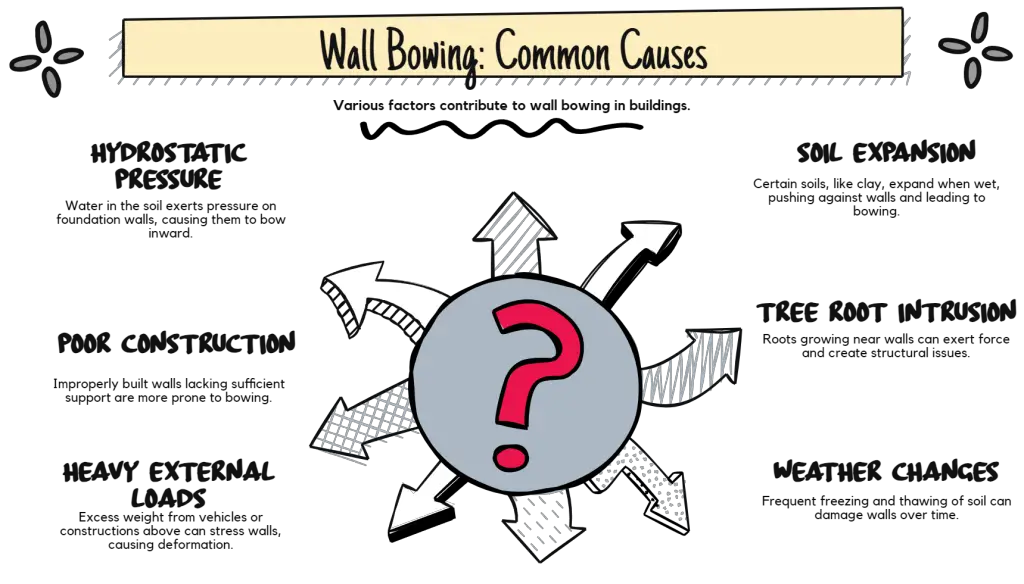As you step into the dimly lit basement, shadows dance across the bowing walls, hinting at the unseen forces at play.
It’s important to contemplate the implications of purchasing a home with such structural concerns. The decision you make regarding this property could have lasting consequences on your investment and peace of mind.
It is not recommended to buy a house with bowing basement walls as it could indicate structural issues that may be costly to repair. It is best to have a professional inspection and assessment done before making a decision.
Understanding the risks and potential solutions is the first step towards managing this complex situation.
Key Takeaways
- Bowing basement walls indicate foundation issues, requiring costly repairs.
- Risks include water damage, mold growth, and potential insurance hikes.
- Prompt evaluation by professionals is crucial to prevent further damage.
- Consider repair options and maintenance for property safety and value.
Risks of Bowing Basement Walls
Understanding the risks associated with bowing basement walls is essential when considering the purchase of a property. Bowing basement walls can indicate significant foundation problems, jeopardizing the structural integrity of the entire building. These issues may lead to water damage, mold growth, and a decrease in property value.
Necessary repairs for bowing basement walls can be costly, ranging from a few thousand to tens of thousands of dollars, depending on the extent of the damage. Buying a house with bowing basement walls could result in higher home insurance premiums and potential future repair expenses, impacting your financial security.
Promptly addressing these concerns is critical to prevent further damage and safeguard the safety and stability of the property. It’s essential to thoroughly assess the severity of the bowing walls and consider the associated risks before making a decision on purchasing the property to protect your investment and maintain a secure living environment.
Assessing the Severity
When evaluating the seriousness of bowing basement walls, it’s essential to take into account factors such as:
- The causes of wall bowing
- The risks it poses to the structural integrity of the house
- The available repair options
Professional evaluation is necessary to accurately determine the extent of the issue and suggest appropriate solutions. Understanding these points will help you make informed decisions regarding the purchase of a house with bowing basement walls.
Wall Bowing Causes
Evaluating the severity of wall bowing in your basement involves examining key factors such as the angle of bowing, crack size, and the condition of the drainage system.
Understanding the causes of wall bowing can help judge the potential risks to your home’s foundation and structural integrity.

Carefully judging these factors can provide insight into the underlying issues contributing to the bowing, guiding you towards appropriate solutions. Remember, addressing these causes promptly can prevent further structural damage.
Structural Integrity Risks
To properly assess the severity of structural integrity risks related to bowing basement walls, consulting with professionals for a detailed inspection is imperative. The assessment involves evaluating the degree of bowing, the presence and size of cracks, and the overall condition of the drainage system.
Understanding the severity of the bowing is essential in determining the potential structural issues and the appropriate steps needed to address them. While not all instances of bowing walls may demand immediate action, prompt evaluation is essential to prevent any escalation of problems.
Repair Options Available
Assess the severity of bowing basement walls with the guidance of professionals to determine the most appropriate repair solution.
When facing issues with bowing walls in your basement, consulting a foundation repair contractor is important. They can evaluate the extent of the damage and recommend suitable repair options.
Carbon fiber reinforcement, priced between £250 to £700 per strap, offers a durable solution for addressing bowing walls in the UK. Wall anchors, ranging from £300 to £500 each, provide stability and support to prevent further wall bowing.
In severe instances, complete wall replacement may be required, although it comes at a higher cost exceeding £20,000. Timely assessment of the situation is crucial to prevent the escalation of structural damage.
Trust the expertise of professionals to guide you towards the most effective repair for your bowing basement walls.
Weighing the Options
When determining whether to proceed with purchasing a house that has bowing basement walls, carefully evaluate the repair costs and structural implications associated with this issue.
The condition of the walls in a house is important as it can impact the overall safety and value of the property. Before making a decision, consider obtaining estimates for the repair costs, which can vary greatly depending on the severity of the bowing.
Additionally, assess the structural integrity of the house to understand the potential risks and hazards posed by the bowing walls. It’s advisable to consult with professionals who can provide insights into the extent of the damage and the necessary actions to rectify the situation.
Ultimately, weigh the costs and risks against the benefits of purchasing the house, keeping in mind the long-term implications of investing in a property with bowing walls. Making an informed decision regarding the purchase of a house with bowing walls is essential to guarantee your safety and financial well-being.
Negotiating Price or Walking Away
To navigate the decision-making process regarding a house with bowing basement walls, consider the potential benefits of negotiating the price or opting to walk away. When considering buying a house with structural issues, keep in mind the following:
- Engage a structural engineer to assess the extent of the bowing and provide a free estimate for repair costs.
- Use the estimate from the structural engineer to negotiate a lower price that reflects the needed repairs.
- Evaluate the impact of bowing basement walls on the property’s resale value before making a decision.
- Calculate the balance between repair costs and potential discounts when deciding whether to negotiate or walk away.
- Remember that walking away from a deal due to severe bowing basement walls may be necessary to avoid excessive repair expenses in the future.
Other Recommended Maintenance
Regularly checking for cracks in walls and foundations and sealing them is a key preventive measure to maintain the structural integrity of your home. It’s essential to address any signs of damage promptly to prevent further issues.
Additionally, monitoring basement humidity levels is vital to avoid mold growth and guarantee a healthy living environment for you and your family. Considering routine inspections by professionals can help detect underlying problems early on, potentially saving you from costly repairs in the future.
In addition to these preventive measures, it’s advisable to pay attention to other recommended maintenance aspects. Ensuring proper drainage around the foundation of your home can greatly contribute to its longevity and structural stability.
Installing wall anchors where necessary can help reinforce bowing basement walls and prevent further deterioration. Regularly inspecting the exterior of the house for any signs of wear and tear is also important in maintaining the overall well-being of your property.
Frequently Asked Questions
How Much Basement Wall Bowing Is Acceptable?
When evaluating basement wall bowing, aim for less than 2 inches for structural integrity. Consulting a professional is essential for limit testing. DIY solutions may not suffice. Consider waterproofing and preventative measures to address any issues effectively.
How to Straighten a Bowed Poured Concrete Basement Wall Yourself?
To straighten a bowed poured concrete basement wall yourself, consider wall reinforcement using steel beams or anchors. Use hydraulic jacks carefully for the DIY method. For safety and long-term stability, consult a professional.
How Do You Fix a Bowing Cinder Block Wall?
To reinforce a bowing cinder block wall, consider wall anchors, steel I-beams, or carbon fiber repair. Professional solutions like these can stabilize and prevent further damage. Act promptly to address the issue for long-term structural integrity.
How Do You Fix a Bowed Wall?
When fixing a bowed wall, reinforce it with steel beams or carbon fiber, ensuring structural stability. Prioritize prompt action to prevent further damage. Seek professional evaluation for the best solution, including basement waterproofing if needed.
Final Thoughts
To wrap up, when faced with the decision of purchasing a house with bowing basement walls, it’s akin to maneuvering through a maze of uncertainties.
It’s imperative to carefully consider the risks, assess the severity of the damage, and weigh the costs of repairs before proceeding.
Seeking professional guidance and exploring all options will ultimately guide you towards making a well-informed decision that aligns with your best interests.
- 10 Surprising Things That Decrease Property Value - April 15, 2024
- How to Buy a Rental Property - April 10, 2024
- Landlords Guide to Normal Wear & Tear in Rentals - April 8, 2024



